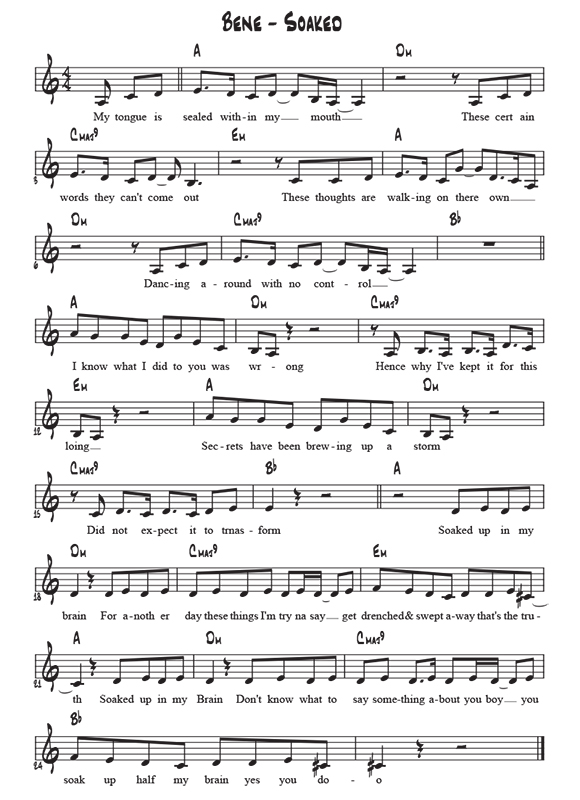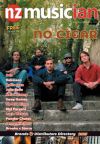X-Factory: Bene – Soaked
X-Factory: Bene – Soaked
And the award goes to… Bene for the quickest earworm I have ever experienced – I think I may have even dreamt about this song last night! The number one New Zealand song (at time of press) is Soaked, enjoying 20 weeks in the Top 20 New Zealand Singles Chart since September 14, 2018.
A young artist from central Auckland, she recently launched her career with two tracks – Soaked, and Tough Guy released February 27 2018. Bene’s youth is reflected in her choice of thematic material, catering to an adolescent audience, relating her songs to perhaps her own experiences, and/or writing for her peers. In an interview with Wickedd Childd, Bene discussed the meaning and the main inspiration behind the song as being inspired by an argument ‘..that feeling of regret you have looking back on an important conversation and wishing that you’d found the right words to say to them at the right time.’
However, Soaked is co-written by Bene, Josh Fountain, and Djeisan Suskov – a noteworthy collaboration, as the level of sophistication achieved (and arguably the success) can be partially attributed to a kind of intelligent-yet-tempered craftmanship or a chilled-but-deliberate musicality. This is hardly surprising as co-writer Josh Fountain was involved (a member of NZ band Leisure, a group with a particularly relaxed vibe). So why is this track so earworm-worthy? Let’s dig deeper (excuse the pun) and find out.
Firstly, Soaked pays homage to soul music heard in the 70s, using classic instrumentation – grooving basslines, relaxed-yet-buoyant drum programming, slap bass, tasteful guitar-ing, and an appropriate tempo for soul – a cruisy 95bpm. Bene’s voice is rich, lush, and soulful, and yet somehow her vocal persona portrays a simplicity too – the girl next door perhaps, natural and honest. The harmony of Soaked, although simpler perhaps than its soul predecessors, is intelligently simple, derived largely from the mode of A Aeolian, but the tonic borrowed from the key of A major instead. Even a Bb major chord heard just before the pre-chorus is a tritone substitution of Em, the 5th chord of A aeolian mode. Tritone substitution is a technique borrowed from earlier, more harmonically rich popular music such as be-bop jazz and soul.
The form is:- Intro (last 4-bars of chorus), Verse, Pre-chorus, Chorus, Verse 2, Pre-chorus, Chorus, Pre-chorus, Chorus, Outro – fairly conventional, and the chord sequence consists of an 8-bar strophe:- A – Dm – C – Em – A – Dm – C – Bb, running almost continually throughout all sections of the song (only breaking at 1m23s).
In a genuine effort to grasp the intelligence of Soaked, we must look at: (1) the chordal/melody relationship, and (2) the rhythmic content. Right from the start, Bene juxtaposes a C natural over an A major sonority, immediately creating a bluesy melody as A major normally has C# as its third; so the C natural acts in this case as the #9.
Then at bar-17, the chorus melody is a simple alternating dyad of D and E spelt over an A major, then Dm, and finally a Cmaj9 chord, creating colour tones of an 11th, 9th, and 9th respectively. Colour tones are often used in melodies to add musical ‘spice’, again another ‘tip of the hat’ to the 70s.

Figure 3 – Use of Colour Tones
Rhythmic content of the melody is also important. Bene used a combination of very regular rhythms (i.e. the chorus being just straight quavers – Figure 3 and Figure 1, bar-9), and also swung (see Figure 1, bar-11) and syncopated elements at the end of almost every phrase (see all figures). The richness of the harmonic, melodic and rhythmic palette in Soaked gives the listener a sense of purposiveness, yet the relaxed groove allows the intelligence to propagate naturally.
There are other noteworthy features of Soaked. Prosody is achieved in lyrics such as ‘soaked up in my brain yes you do’, where the dry vocal alludes to an absorption of reverb, and the BV’s heard in verse two are almost deliberately out of reach, congruent perhaps to the meaning (i.e. not being able to find the right words at a crucial moment). Techniques such as dropping the drums out for a bar (verse 2 and pre-chorus 3) help draw focus, and very subtle additions of instruments, such as an almost-inaudible xylophone in a latter pre-chorus, again underscore the sophistication to the production.
There is no forward motion in the chorus which is unusual. Usually, the chorus has a pickup line (often the hook), which drives the listener forward. Interestingly this doesn’t happen here as the chorus melody starts on beat 3. Other solid production techniques include using a combination of conventional band instrumentation with electronic production (analogue synths or emulations), extensive use of dreamy reverb combined with dry-vocals, and antiphony between lead and harmonies.
Perhaps it is ironic that Soaked was ‘soaked’ up in my brain as an earworm. Personally, I feel that it is a case of ‘watch this space’ for Bene. Her melodies are infectious and her collaborations are particularly fruitful. In time I suspect that she may explore deeper themes lyrically, but what a solid, intelligent, groovy, and musical start!




